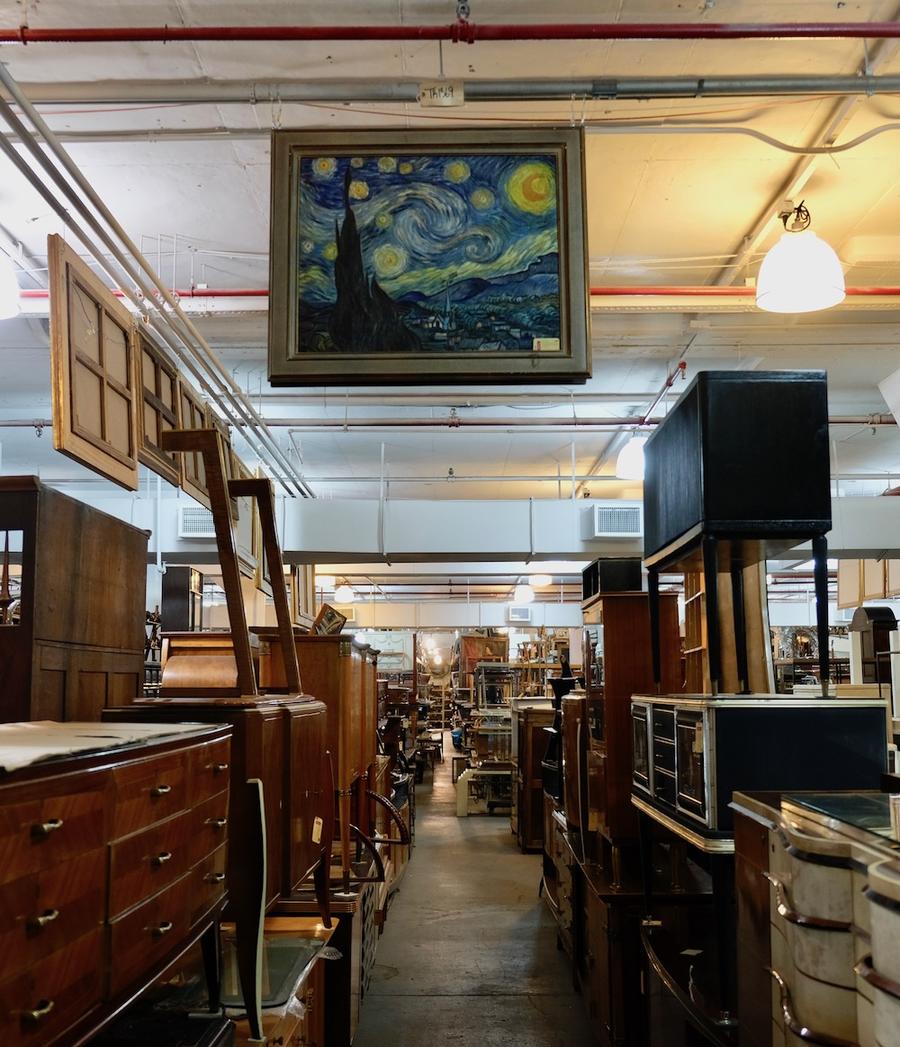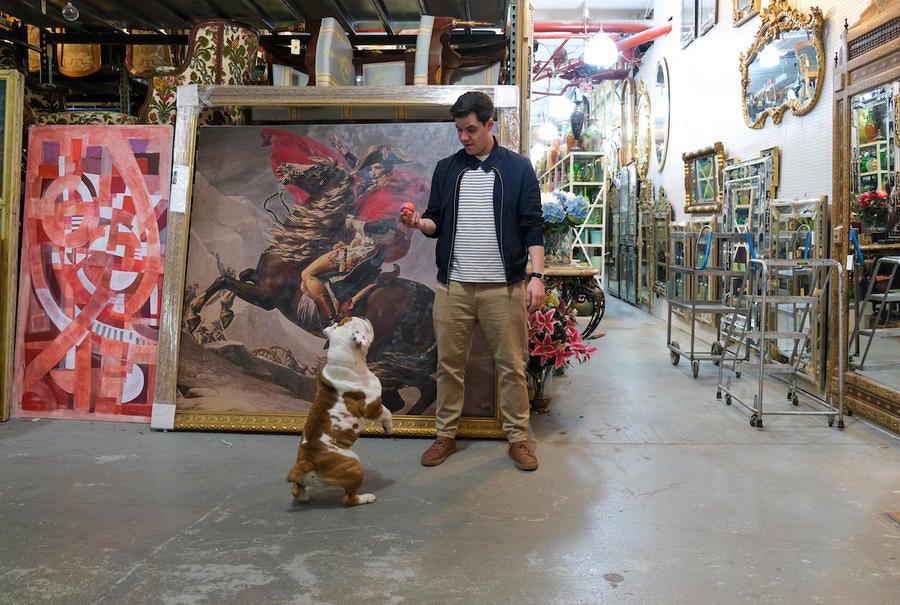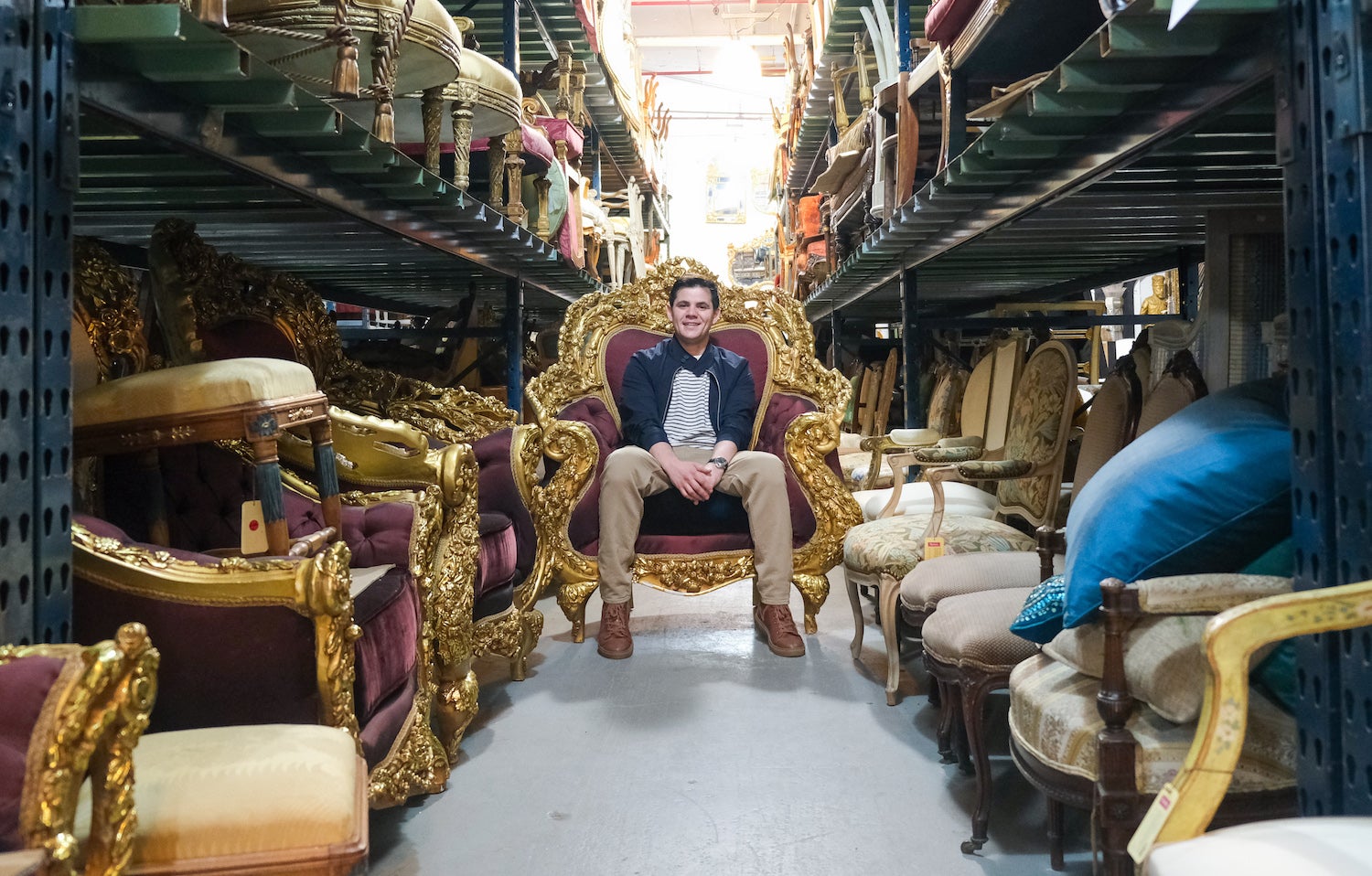Jake Baer, the 31-one-year-old CEO of an 80-year-old antiques business, knows what’s going to happen on Saturday Night Live a day in advance. Every Friday, he welcomes the long-running NBC comedy’s set design team into his Ali Baba cave of a Long Island warehouse to rent pieces for the next day’s show. This season, the refined parlor where Emma Thompson memorably slapped a teacup out of Leslie Jones’s hand? Most of the furniture came from Baer’s company, Newel. Background paintings for an endless parade of White House sketches? Newel.
On a recent Friday in May, longtime SNL production designer Keith Raywood was taking a break from the show’s hectic production schedule, conferring on a couch in Newel’s lobby with two associates. Jim Balzaretti, one of the show’s property masters, was retiring in the summer, and Baer had laid out a spread of bagels and schmears as a farewell. It was the final episode of the season, and the mood was light. “We come here for special pieces, stuff you can’t find anywhere else,” said Raywood. “Today we needed some stuff for the Oval Office. And there’s actually a sketch set in an antique shop. So that’s easy.”
The meeting had a casual, routine feel—and indeed, Raywood had been renting from Newel for decades. But SNL’s relationship with the antiques business has grown significantly in the past three years, the result of Baer’s courtship. Since taking over from his father in 2016, the young CEO has been on a quest to cultivate better relationships with New York’s film community, part of an ambitious effort: to grow his family’s antiques business in a time when no one is buying antiques.
***
It’s difficult to overstate how rough the past two decades have been on antique dealers. In the 1980s and ’90s, the market for centuries-old French and Italian pieces enjoyed a 20-year boom. Decorators would walk into antique shops and outfit clients’ entire homes, and shelter magazines were thick with Louis XIV and Federal sideboards.

At the turn of the century, the market began to slip—especially in New York. Some point to the glut of sleek contemporary high-rises with open floor plans (floor-to-ceiling glass windows and brown furniture don’t mix). Others blame it on a generational shift toward more minimal interiors and a casual lifestyle. Whatever the cause, the effects have been catastrophic for dealers. Prices are at 20-year lows, and countless once-venerated shops have closed.
In the midst of this decline, Baer graduated from Marist College and began working full time in his family’s business. Newel, founded in 1939 by Baer’s great-grandfather, had become one of the largest antique dealers (if not the largest) on the East Coast, with a stock of over 20,000 pieces. Size offered little protection against a bear market. “I feel like I never really got to experience the wild times my father talked about,” Baer told Business of Home. “He used to say you could put any piece into the store and people would walk in and buy it.”
Most of the dealers that have survived the drought have done so either by scaling back radically or pivoting—often away from antiques. Maison Gerard and Bernd Goeckler, for example, developed work by high-profile contemporary makers that they sell alongside their vintage offerings. Others shifted their businesses to operate mostly online. Newel had done neither. “We really were in the mindset of ‘sales sales sales,’” says Baer. “We didn’t feel like we were catering to the sales environment as well as we could.” But despite a sleek new gallery designed by Jim Aman and an investment in trendy midcentury pieces, Newel was struggling.
At the same time, another side of the business was showing signs of growth. In 2010, HBO’s Boardwalk Empire, a Prohibition-era drama set in Atlantic City, began renting props from Newel. Baer says that over the course of five seasons, the production rented over 7,000 pieces, generating revenue in the high six figures: “During a time when sales might not have been so great, we had this extra income. Especially during down months, it was our backbone.”
For Newel, renting antiques instead of selling them was not a new business. In fact, the company was originally founded as a prop house catering to Broadway in its golden age. Even as its core business model shifted to buying and selling, Newel kept renting. However, the prop side of the business was marketed at a whisper, and by the time Baer began working full time, it only made up 10 percent of the company’s revenue.
As Boardwalk Empire wound down in 2014, New York’s film community was gearing up. An explosion of online streaming platforms like Netflix and Hulu had created a demand for new shows, many of which were filming in the massive Silvercup and Kaufman Astoria studios in Queens, a half mile from Newel’s new location in Long Island City. (The company moved from its longtime Manhattan home on 53rd Street in 2015.) A $420 million state tax credit for film production added fuel to the fire, and Baer sensed an opportunity: “It was a perfect storm. All these shows need stuff, and I started to push for making a change to market to set designers more.”
Change didn’t come immediately at Newel. “Our online presence wasn’t where it should be, and I was getting frustrated,” says Baer. “We weren’t even showing rental prices on our site. It was just a tiny blurb on our ‘about’ page.”
***
In 2016, Baer took over from his father as CEO of Newel. His first move was to purchase the inventory of a struggling prop house. At 10,000 pieces, it significantly increased Newel’s stock, especially its collection of “smalls”—the decorative objects that production designers use to put the finishing touches on a set.
Having the inventory was one step, pricing it properly was another. For years, Newel had charged a 10 percent rental fee on every item in its inventory. It was a policy designed to avoid complicated accounting—an easy way for an antiques business to make money on the side without getting into the weeds. For a props business, it made no sense.
“Say I had a piece that would sell for $50,000,” said Baer. “The old way would be to rent it for 10 percent—but $5,000 is too high for a rental; I don’t need to ask that much. It works the other way too. I could rent this sofa for $1,000. But is it worth $10,000? Probably not.” (The sofa in question, a Chesterfield with a tight back, can been seen in Kanye West’s music video for “Monster”—Jay-Z raps in front of it while a blow-up doll lies sandwiched between the cushions.)

Baer spent weekends combing through Newel’s inventory, determining rental and sale prices for each item. He then created a separate brand and website for the rental business—Newel Props—that was calibrated to the needs of the chaotic, need-it-yesterday pace of set design. When he was finished, Baer had pulled off a neat trick: creating two businesses out of one inventory.
The move was not without its controversy. Several longtime Newel employees left during this period. “There were some people who didn’t want to be part of the change,” says Baer. “They were more on the sales side, and when I took over the business, they weren’t fully in line with the overall vision—there was a lot of change to the culture.”
The change also carried another risk: In the sniffy world of high-end antiques, it may deter some potential buyers to hear that a coveted armoire was recently used in a Claritin commercial. For that reason, Baer was careful to maintain some segregation between the two sides of the business, both physically and digitally. Though the Newel Props and Newel Antiques websites feature nearly identical stock—two different windows on the same view—the sites don’t explicitly link to each other. And in addition to the sprawling LIC warehouse, Baer maintains a traditional showroom in Manhattan and a presence at the 1stdibs Gallery on the West Side—both environments tailored explicitly for selling, not renting.
Baer says the push toward rental hasn’t hurt his sales, and that his numbers are up 30 percent since last year. Unsurprisingly, the rental side is booming. “Three years ago, rental was 10 percent of our business,” says Baer. “Now it’s 60 percent.” He’s grown Newel’s staff from 10 to 17, and recently hired a CTO—novel for an antiques company—to help streamline the company’s database and websites. Meanwhile, Baer is acquiring more stock and looking for warehouse space to store it in.
***
As Raywood and his SNL crew packed up their bags and headed back to 30 Rockefeller Plaza, Baer led a quick tour through Newel’s warehouse. Here, a spherical midcentury German chair in bright yellow—it looked a bit like Pac-Man, split open ($3,500 to rent, $48,000 to own). There: a red recamier that Beyoncé once danced on at the VMAs (not for sale, though you could recline on the same upholstery as Queen B for $1,400 a week).
Baer was brimming with enthusiasm for Newel’s collection, a kid in a candy store, pointing out favorite pieces and reeling off ideas he hopes to roll out in the years ahead—a line of contemporary furniture to compete with Bernd Goeckler’s and Maison Gerard’s; a staging business to take advantage of Manhattan’s real estate slump; a location in Georgia that will profit from the state’s lucrative film tax credits.
And just in case the pendulum swings back on antiques, Baer will be positioned to cash in. “Who knows? In 20 years, antiques could be the most vogue thing in the world, and I’ll have a lot of them,” he said. “In the meantime, I’ll be renting.”
Homepage photo by Fred Nicolaus




























